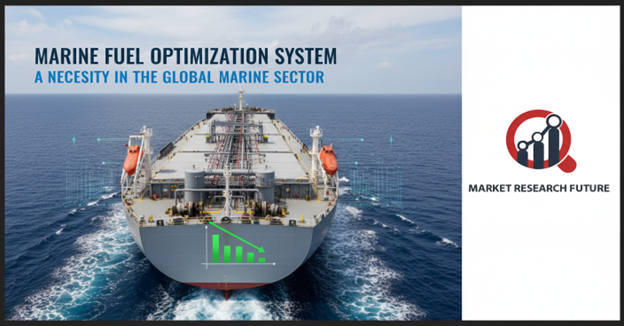
Marine fuel optimization systems Market Overview
The global marine industry is undergoing a major transformation, driven by growing environmental concerns, rising fuel costs, and stricter international regulations. Marine fuel optimization systems have emerged as an essential solution to monitor and manage fuel consumption effectively, improve operational efficiency, and reduce emissions across marine vessels.
A marine fuel optimization system enables ship owners and operators to measure, track, and analyse the exact amount of fuel consumed by engines, generators, and auxiliary systems—both at sea and in port. Beyond tracking fuel usage, these systems deliver comprehensive insights into voyage performance, operational inefficiencies, and emission levels, helping operators make data-driven decisions that enhance vessel efficiency and regulatory compliance.
According to industry analysis, the global marine fuel optimization market is poised for significant growth through 2023, supported by rising seaborne trade, increasing environmental awareness, and regulatory mandates from the International Maritime Organization (IMO) aimed at curbing greenhouse gas emissions.
Leading players such as DNV GL, ABB Ltd., Siemens AG, and Emerson Electric Company collectively account for more than 50% of the market share, leveraging advanced analytics, IoT integration, and cloud-based platforms to deliver real-time fuel management solutions.
Market Growth Influencers
1. Regulatory Pressure and Emission Norms
Stringent global regulations, particularly those established by the IMO, are driving adoption of fuel optimization systems. With shipping responsible for approximately 2.8% of global CO₂ emissions and significant NOx and SOx contributions, regulatory frameworks now mandate stricter monitoring and reporting of fuel usage.
2. Rising Fuel Costs
Fuel remains the largest operating expense for marine vessels, often accounting for 40–60% of total voyage costs. Fuel optimization systems help reduce consumption, enhance voyage planning, and minimize wastage—resulting in substantial cost savings.
3. Expanding Seaborne Trade
With 90% of global trade conducted via shipping, continuous growth in international trade volumes is driving demand for fuel-efficient operations. According to UNCTAD, maritime freight contributes approximately 380 USD Billion annually to the global economy, reinforcing the importance of fuel management solutions.
4. Technological Advancements
Integration of IoT, AI, and data analytics enables real-time fuel monitoring and predictive insights. Tools such as DNV GL’s PSC Planner help ship operators benchmark performance and prepare for inspections, improving compliance and efficiency.
5. Strategic Partnerships and Product Innovation
Major market players are focusing on product launches, collaborations, and R&D to expand geographic presence and meet evolving customer demands. Product innovation remains a key strategy for sustaining competitive advantage and aligning with environmental objectives.
Market Segmentation
For a comprehensive understanding, MRFR segments the marine fuel optimization market as follows:
By Component:
- Fuel Flow Meters
- Monitoring Systems
- Reporting & Analytics Software
By Application:
- Fuel Consumption Monitoring
- Fleet Performance Management
- Emission Control & Reporting
By End-User:
- Commercial Shipping
- Offshore Support Vessels
- Naval & Defense Vessels
By Region:
- North America
- Europe
- Asia-Pacific
- Middle East & Africa
- Latin America
Regional Analysis
Europe dominates the global marine fuel optimization market, led by countries such as Norway, Germany, and Switzerland, which host several major industry players. Stringent environmental policies, advanced maritime infrastructure, and strong technological capabilities support regional growth. The Asia-Pacific (APAC) region represents one of the fastest-growing markets, fuelled by increasing maritime trade, expansion of shipbuilding facilities, and regulatory initiatives in China, Japan, and South Korea. Local manufacturers are investing in R&D and expanding operations to capture growing regional demand.
North America is a key contributor to market development, driven by strong shipping activity, digital transformation in marine logistics, and environmental compliance mandates. Emerging economies such as Saudi Arabia, UAE, and Brazil are gradually adopting fuel optimization technologies as part of broader maritime modernization efforts, supported by growing port infrastructure and government-led sustainability programs.
Prominent Market Players
Leading companies shaping the global marine fuel optimization market include:
- DNV GL AS (Norway)
- ABB Ltd. (Switzerland)
- Siemens AG (Germany)
- Emerson Electric Company (U.S.)
These key players collectively contribute over 50% of the market share, focusing on digital solutions, IoT integration, and emission monitoring to help ship owners enhance operational efficiency and meet regulatory compliance.
Other notable participants include emerging regional firms and SMEs offering localized solutions tailored to specific fleet requirements.
Conclusion
The global marine fuel optimization system market is transitioning from an optional efficiency tool to a strategic necessity. Driven by environmental regulations, cost pressures, and technological advancements, the industry is rapidly adopting smart fuel management solutions to ensure compliance and competitiveness.
As the maritime sector navigates the twin challenges of sustainability and profitability, fuel optimization systems will play a critical role in enabling data-driven operations, lower emissions, and optimized fuel usage, fostering a cleaner and more efficient global shipping ecosystem.